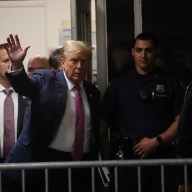 MTA officials said MetroCards were only being refilled about 60 percent of the time before the fee was put into place, netting the agency about $11 million in dollars and cents that went unused when cards were tossed aside.
MTA officials said MetroCards were only being refilled about 60 percent of the time before the fee was put into place, netting the agency about $11 million in dollars and cents that went unused when cards were tossed aside.
Credit: Miles Dixon/Metro
For years, the MetroCard have been as ubiquitous to subway station floors and trash cans as they were to the pockets, purses and wallets of the millions of New Yorkers who ride the subway system.
That’s not quite the case anymore. The Metropolitan Transportation Authority created a dollar surcharge for every new MetroCard, a “green fee” to drive down waste and create new revenue for the often cash-strapped agency.
More than a year since the fee was put in place March 2013, the MTA said it brought in $24 million in overall revenue.Take into account the money the agency lost in unspent balances and production costs and officials said the surcharge netted the MTA $14.7 million in actual profit.
That’s short of what officials originally expected. A few months into the program, the MTA thought the cost savings and fee revenue would result in $20 million in net revenue.
“That estimate has since been reduced due to a higher-than-expected refill rate,” MTA spokeswoman Amanda Kwan said in an e-mail.
“But even though the revenue is lower,” she added, “the program has been successful in reaching the goal of encouraging customers to reuse their MetroCards and reducing litter in stations.”
Overall, the transit authority said MetroCards were only being refilled about 60 percent of the time before the fee was put into place, netting the agency about $11 million in dollars and cents that went unused when cards were tossed aside.
Today, nine out of every ten subway rider is refilling their card and letting that leftover change add up.
Yvette King, an attorney who commutes between her Westchester and Financial District office, said she just bought a new 20-day unlimited card.
“I’m not crazy about the $1 fee. I try to avoid it,” King said, adding she understood the need for waste reduction.
The MTA produced almost 160 million MetroCards every year at a cost of $10 million annually. While officials were unable to say how many cards were produced in the year since the green fee was put in place, they estimate saving at least $3 million in production costs.
 The MTA produced almost 160 million MetroCards every year at a cost of $10 million annually. While officials were unable to say how many cards were produced in the year since the green fee was put in place, they estimate saving at least $3 million in production costs.
The MTA produced almost 160 million MetroCards every year at a cost of $10 million annually. While officials were unable to say how many cards were produced in the year since the green fee was put in place, they estimate saving at least $3 million in production costs.
Credit: Miles Dixon/Metro
MetroCards can last for about a year before they need to be replaced. Customers can see the expiration date on the back of their card or at a vending machine.
Once a card expires, customers can still use the vending machine to get a new card at no additional cost.
Gene Russianoff, senior staff attorney with the Straphangers Campaign commended the policy one year in, noting New Yorkers’ adaptability even if some might still complain.
“You sort of have two behaviors here. You have people who might just throw their cards to the ground with their extra money on it and not care — lose a dollar, a quarter,” he said. “But they’re angry at the thought of losing a dollar.”
When the fee was announced in 2012, the Straphangers Campaign pushed to use any extra money towards keeping the stations clean.
In at least one sense, the subway stations are little cleaner for Russianoff, who said he has noticed fewer MetroCards littered around the stops.
But that dollar fee still doesn’t make sense to some transit riders.
Shakisha Brake, 35, lives in Brooklyn and says she goes through too many of the thin, plastic cards, buying a new one every week.
“It doesn’t make any sense,” Brake said. “I often have to buy a new one because they get bent or lost easily.”
Brake said the usual hikes in overall fares don’t help either.
“It’s hard to get around when going out anywhere is gonna cost you $5 at the end of the day,” she said. “And what if you only have $30 on you for the weekly pass, and you needed one more for the fee?”
Additional reporting by Samar Khurshid.
Follow Chester Jesus Soria on Twitter@chestersoria














